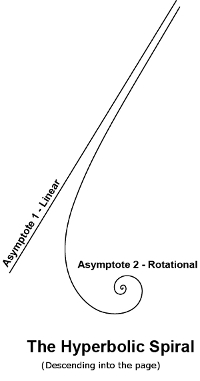The Hyperbolic Spiral is a specific exponential form that is of critical importance to Aikibojitsu and Aikido. Like the general exponential curves discussed on the previous page, the Hyperbolic Spiral has two asymptotic limits, but in this case, one rotates downward, sinking into the earth, while the other extends outward; the two limts are orthogonal to each other (perpendiculat in three dimensions).
The Precessional Yokomen strike of Aikibojitsu (shown on the previous page) is always thrown full power, without any thought of pulling the strike. For this to be viable, a highly effective and precise means of energy control must exist, integral with the strike, a means that will, absent any further intended action, determine the limits of staff travel in space. This is particularly important because advanced Aikibojitsu paired practice is likely to involve full-power strikes close in to an opponent's head or body, creating a situation where any imprecision in staff control cannot be tolerated.

Aikibojitsu bases both power generation and strike control upon the structure of the hyperbolic spiral, a preformal entity which contains within its structure two asymptotic limits. The Yokomen strike is generated by throwing power into one asymptotic limits (rotational and downward), and controlled by allowing the other asymptotic limit (linear) to limit that power. This spiral should be considered to originate far out along the linear asymptote, descending, coming toward nage. As the spiral approaches the practitioner's body, its rotational component increasingly asserts itself and finally rotationally plunges strongly downward into the Earth. The center of the vertical asymptote is found between the practitioner's feet, slightly shifted towards the back foot.

At the beginning of the basic strike, the practitioner is in chudan kamae. At the final position of the strile, the staff will be angled across the line of intent (the line segment that connects uke and nage center to center), the left hand (holding the end of the staff) positioned in front of the solar plexus, and the right hand (holding the fundamental node) at roughly shoulder level.
The strike is made with a downward pulse of power into the spiral's rotational pole, as if the staff and body are one. The strike's final position will be determined by the practitioner's placement of the spiral's linear asymptotic limit. In the final position, the arms are more or less parallel, while the staff is more or less parallel to the front surface of the body. This creates a parallelogram structure that is shifted slightly towards uke. The slight shift is important because it changes the shape from a rectangle to a parallelogram whose structure of better at providing strengt to the final position.
Practitioners, knowing that the spiral's singularity contains integrated strike control, are freed from the need to "pull" a strike, and instead are able to throw power with full commitment, without worrying further about the ultimate destination of that energy.
Hyperbolic control doesn't require modification of original striking intent, and the integrated strike based upon hyperbolic strike control greatly reduces the likelihood of field reversal in the martial interaction. Hyperbolic strike control is based upon throwing the energy of the Yokomen strike into the preformal structure of the hyperbolic spiral, rather than at uke in particular. It is a strike into two infinities simultaneously (although phase-separated), those infinities bound into a singularity by the spiral form.

